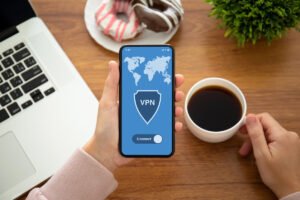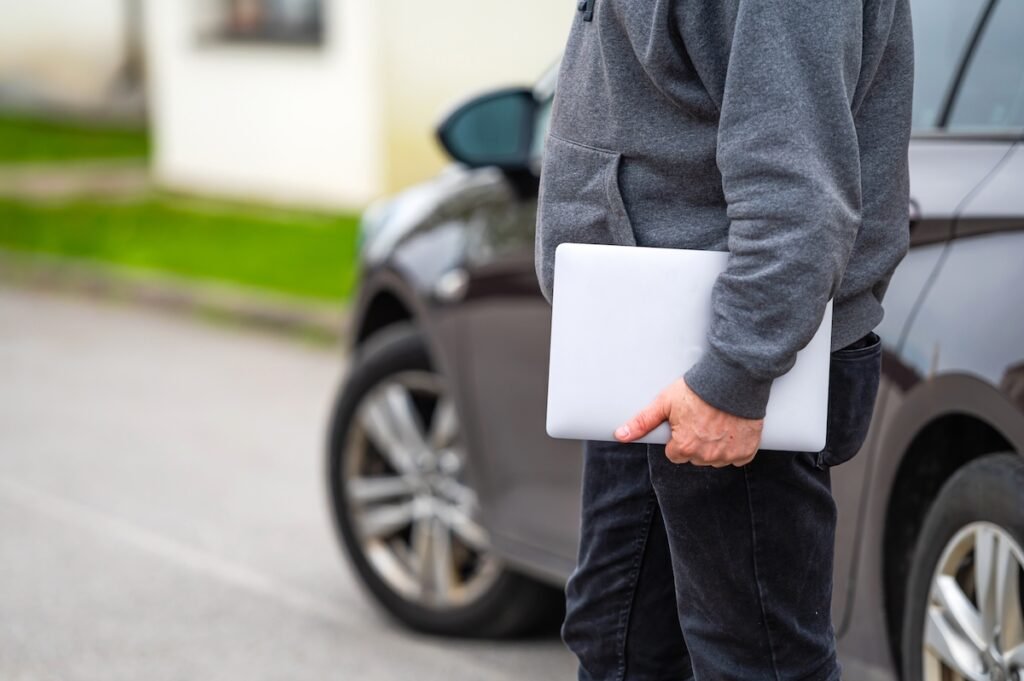How important is it to secure your home WiFi network? One thing I notice is a lot of people I know do not have a secure home network. Whenever I ask why this is the case, most of the time people are just confused and don’t think they’re “techy” enough to do these kinds of things. It’s so easy though! If you can read and follow basic instructions, you got this! There are so many ways to secure your network, but I wanted to walk you through five of what I think are the easiest and simplest ways to secure your home Wi-Fi network. You want to make sure your home is a safe place to get online, right? This is also an important approach to adding one more layer of protecting your devices and your personal data as well. This is so easy you can literally do this in about 5-10 minutes, even if you aren’t the “tech type” and don’t speak geek. Your network security in your home is vital. And it’s one of those often overlooked safety measures. Privacy on things like your mobile devices, tablets, computers, laptops, and smart devices could be compromised by even the most novice hackers.
It’s pretty crazy how many people just use the basic setup for their home network and forget about it. They take the password and the SSID that they were given by their Internet provider (probably written on a box for the world to see), and that’s what they use. If this is you (we’re not judging by the way), you’re definitely going to want to take notes immediately after reading this. Make these adjustments! Promise? Okay. Are there more advanced steps to making your network and home WiFi more secure? Sure, but I just want to share with you a handful of basic tips you can do right now. First things first, you’re going to want to be by your router. We’re going to begin this process there. We will be making some of these security steps in the network settings. Most of them will be in the same place. Your router is going to look something like this….
Protecting Your Home WiFi Tip #1
You might want to go where your router is located to help get a visual of what we’re talking about in this tip if you want to. It’s not necessary, but it might help. You want to be looking at your router in order to find the information to log in to the administration panel. With most routers, the login info generally is going to be on the bottom, on the back, or the side where you can find a six or seven-digit code along with a password that’s printed on it. The info will also be in a manual (and you can typically Google your router model number and find it online). Usually, it’ll say something like “Router Login” or something to that effect. I’m not exaggerating when I say my login settings have the username as “admin” and the password as…yes…“password”.
What you’re looking for, or the first thing that you want to change is the SSID. This is the ID that comes up when you’re searching for Wi-Fi. What you may not realize is that a lot of these IDs can be tied back to the manufacturer of that particular router. Scary? Yeah, no doubt. Some routers may have known vulnerabilities. Hackers know this and if they see that particular ID will know exactly how to hack it. In addition to this, the default SSID may also be an identifier to know which Wi-Fi is related to a specific house that might be really expensive (or have valuable inside of it). It’s something someone with technical know-how and expertise might definitely want to hack into. They have their checklists, they have their processes down to a science, and SSID is an easy entry point into your personal data. These dangerous people out there exist. What you want to do is just rename your SSID name. Try not to make it too personally identifiable. You’ll want to avoid making it your name. Don’t imitate a private network. I see this a lot and it just invites people to join, which will slow download and upload speeds. Use a little common sense. A lot of people like to have fun with these SSIDs and that’s not a bad thing, but it’s best to err on the side of caution and keep personal stuff out of the SSID. Honestly, just changing it is going to add a layer of security. But make sure you know exactly what it is. This won’t make your home WiFi incredibly secure, but a small change like this can help quite a bit.
How Do I Change My Home Wifi Name?
This is really easy. These instructions are general for most router types. You need to access your router’s admin page (you can find this on the back or bottom of the router).
- Step 1: Enter the router’s IP address into your favorite browser
- Step 2: Log in as the administrator. You can find that info again on the router.
- Step 3: Click on “Settings” (or similar verbiage) and you’re going to want to find the option “SSID Name” or “WiFi Name”. It should be one of those options.
- Step 4: Enter your new WiFi name (follow our guidelines above). In some admin panels, you’ll have to hit save or “apply”.
TRENDING: Should I Enable DNS Content Filtering?
Protecting Your Home WiFi Tip #2
While you’re in the router admin settings, the next thing you want to do is to set up a new, more secure password. Most likely, your Internet provider gave you a password, then set up your Wi-Fi with password protection. And that’s fine, but you really want to do something a little more secure and something you can keep track of more easily.
A couple of things with this. First, you want to create a strong, unique password. Do NOT create a password like one of these common Wifi passwords (and yes…these are legit passwords and I can’t believe people actually do this, but they do). Personally, I use a password generator and a password manager like Keeper or Zoho Vault, but there are a lot of really good password managers out there. Secondly, in the same place where you changed the SSID, you’ll want to change the old password with this new password. It’s usually in a field called “Password” or possibly “Passphrase” depending on the brand and type of router. Once you make those changes, press “apply”.
Protecting Your Home WiFi Tip #3
While you’re still in those admin (or advanced or something similarly named) settings for your router, another thing you want to look at is disabling remote access. It’ll usually be on a “Security” tab or something close to that. You’ll want to find a navigation label with “Remote Control” or “Remote Access”. Honestly, there are very few times when I’ve used remote access for my router. I can’t remember the last time I’ve used it to tell you the truth. What is remote access? If you’re not physically present near the Wi-Fi router (can’t access the signal essentially), remote access gives you the ability to dial in from another location. As I said, I’ve rarely used it and most people never do anyway. It’s just an extra vulnerability you don’t need for your home network. For most people (like 99% of the population), it’s an advanced feature. You’ll want to disable that feature and click “apply”.
LEARN MORE: Your Home Automation Questions Answered
Protecting Your Home WiFi Tip #4
Okay, this next one is really easy and I think is probably the most important. If you have a lot of guests (think extended family, friends, visitors, etc), one of the things that happen is you tend to give out your Wi-Fi password. My wife literally just did this today with an extended family member and I had to remind her why we have a Guest Network. What happens is that Wi-Fi password gets stored in their devices for a long time (probably indefinitely). If you were to look into your Wi-Fi settings right now on your smartphone, tablet, or laptop, you’d find quite a few networks that are stored and saved on your device. What this means is they also could potentially have access to your home network, depending on how it’s set up. It’s not just the internet they get access to either. It could even include your internet of things (IoT) devices like your Alexa or your Google Assistant. Or perhaps your smart lights and smart thermostat. Maybe even your security cameras. All of these things.
TRY THIS: If You Use A Browser, Do This Now!
So this home network security tip is really important: create a separate guest WiFi network. This can be done in a number of different ways (I love how easy Google Wifi has made it). But you’ll want to set up a separate Wi-Fi network for guests and other people with a different password than your main WiFi. What this will mean is you will have a Wi-Fi network that’s secured specifically for your family and your devices. And then a separate network for any guests that come in. The next time you have guests asking for the WiFi network and WiFi password, this way you’re not giving away your secure password that might be used for other things like email, banking, etc. I once had a friend who used the same password for everything. As a teaching moment when he gave me his home WiFi password, I tried the same password for his email and immediately accessed his email. I let him know, of course, and encouraged him to immediately change them all. If you use something like Google Wifi, Apple AirPort, or some other advanced routers, they have an option for a guest ID, which makes it super easy to set up. What I LOVE about these is it sets up a completely separate Wi-Fi network, so guests don’t have access to your home network at all.
Protecting Your Home WiFi Tip #5
Lastly, this one is by far the easiest. This is something probably not done that much but can be important. Depending on the level of home automation and what kind of smart devices you use, it might not be applicable to you at all. If you’re going on a vacation or you’re leaving your house for more than just the regular hours of work or possibly for an extended amount of time, it can be a great idea to turn off your Wi-Fi. There’s no reason to have your Wi-Fi on, especially if you don’t have a lot of smart devices. Even if you do have an Alexa or Google Assistant, it may not be a bad idea to turn the WiFi off. These devices can act as other access points to your home network. There is one caveat though: if you have a smart thermostat, a Ring camera (or something similar), smart lock, or a smart lighting system programmed or scheduled to keep burglars away, you won’t want to utilize this last tip. But if you aren’t into the home automation stuff and don’t have those extra security measures leveraging smart devices, then turning your WiFi completely off when you’re going to be away for an extended period of time is a really useful tip. We would highly recommend that you do get into the home automation space and begin to learn how effective smart devices and smart technology can help make life a little better.








